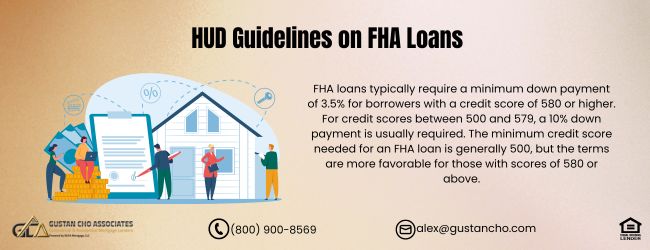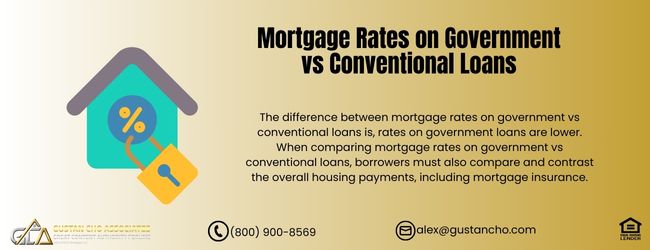HUD Guidelines on FHA Loans

This guide covers HUD guidelines on FHA loans. HUD, the parent of FHA, sets the mortgage guidelines and the minimum lending standards on FHA loans. HUD is not a mortgage lender. HUD is a giant government agency that insures lenders in the event borrowers default and foreclose on FHA loans. The minimum agency mortgage guidelines on FHA loans is set by the U.S. Department of Housing and Urban Development, HUD.
In order for a mortgage lender who is FHA approved to get all FHA loans insured by HUD, they need to meet the minimum standards set by the Federal Housing Administration.
The U.S. Department of Housing and Urban Development (HUD) sets guidelines for FHA (Federal Housing Administration) loans to make home-buying more accessible to those with lower credit scores and smaller down payments. In the following paragraphs, we will cover some key aspects of HUD guidelines on FHA loans.
What is the Role of the U.S. Department of Housing and Urban Development
HUD is the parent of the Federal Housing Administration. HUD is not a lender. HUD is a government entity that insures mortgage loans in the event of a borrower defaults on their FHA loan. In the event borrowers defaults on their FHA loans and the property goes into foreclosure, HUD will cover the loss to the mortgage lender.
HUD sets their minimum lending standards, called HUD guidelines on FHA loans. Mortgage lenders can have higher lending requirements on FHA loans called lender overlays.
It is up to the particular lender to impose stricter standards on top of the minimum HUD guidelines on FHA loans which are called lender overlays. The additional requirements imposed by individual mortgage lenders are call mortgage overlays. HUD approved lenders can impose much stricter lending standards than the minimum HUD guidelines on FHA loans. Click here to apply for a FHA loans
What Are FHA Loans
FHA loans typically require a minimum down payment of 3.5% for borrowers with a credit score of 580 or higher. For credit scores between 500 and 579, a 10% down payment is usually required. The minimum credit score needed for an FHA loan is generally 500, but the terms are more favorable for those with scores of 580 or above. FHA loans are assumable, meaning a future buyer can take over the loan under the original terms, subject to credit approval and lender guidelines.
HUD Guidelines on FHA Loans: Mortgage Insurance Premium
Borrowers must pay two types of mortgage insurance for FHA loans.
- Mortgage Insurance Premium (UFMIP): This is typically 1.75% of the loan amount, paid at closing, but can be rolled into the loan.
- Annual Mortgage Insurance Premium (MIP): This is paid monthly and varies based on loan amount, term, and loan-to-value ratio (LTV).
HUD guidelines usually allow a higher debt-to-income ratio than other loan types. The maximum DTI is typically 43%, but it can be higher in some cases if there are compensating factors. The home must meet HUD’s minimum safety and security standards, assessed during an FHA appraisal. It must also be the borrower’s primary residence.
HUD Guidelines on FHA Loans: Standard Lending Limits
HUD has maximum lending limits depending on the county the home is located. Certain counties throughout the United States where the government deems it as a high-cost area have higher FHA mortgage lending limits than the standard FHA loan limit. We will just cover the standard FHA loan limits. There are counties throughout the United States where home prices are higher than the median home prices in standard areas and is called high-cost areas. FHA loan limits in high-cost areas is higher than median priced areas. High cost areas in California are the following areas:
- Los Angeles
- Irvine
- Pasadena
- San Diego
- Laguna Nigel
- LaJolla
- Newport Beach
- San Jose
- San Francisco
- Modesto
- Berkeley
- Oakland
- Lake Tahoe
- San Bernadino
- Burbank
- Monterey
- Palm Springs
- Long Beach
- Santa Barbara
- Anaheim
- Sacramento
- Belmont
- Fresno
- Santa Monica
- Menlo
- Mountain View
- Beverly Hills
- Santa Cruz
- Palo Alto
- Riverside
- Stockton
- Malibu
- Carlsbad
- San Luis
- Obispo
- Temecula
- Torrance
- Huntington Beach
- Napa
- Camel-By-The-Sea
- Santa Rosa
- Eureka
- Fremont
- Redding
- Ontario
- Orange
- Hollister
- Murrieta
- Chico
- Vallejo
- Ojai
- Calabasas
- Chrome
The above areas are in high-cost areas where the FHA lending limits are substantially higher than the standard FHA loan limits. FHA loans have maximum borrowing limits that vary by location and are updated annually.
HUD Guidelines on FHA Loans: Standard versus FHA High-Cost Loan Limits
Standard FHA lending limits for a single family unit is $498,257. For high-cost areas, the maximum FHA lending limit for properties in high-cost areas are capped $1,149,825 on single-family units. For two-unit residential properties, the standard FHA lending limits are at $637,950. The maximum FHA lending limit for two unit residential units in high-cost areas is capped at $1,472,250. Standard FHA lending limits for 3 unit properties is set at $771,125. For high-cost areas, 3 unit properties FHA lending limit is capped at $1,779,525. For four units, standard FHA lending limits are at $958,350. Maximum FHA lending limit for four-unit residential properties in high-cost areas is capped at $2,211,600. Qualify for a FHA loan with bad credit , click here
Terms of FHA Loan Programs
HUD offers 10 year fixed rates, 15 year fixed rates, 20 year fixed rates, and 30 year fixed rates. FHA also offers 30-year adjustable rate mortgages, called ARM. FHA insured mortgage loans are for owner occupant primary residences only. Any owner-occupant can qualify to purchase a one to four units residential property. This is called the FHA 203(b) mortgage program. The FHA 234(c) mortgage loan program is for those home buyers who want to purchase FHA approved condominium units. The FHA 203(h) mortgage loan program is for disaster victims. The FHA 203(k) loan program is a construction and acquisition mortgage which is rolled into one mortgage loan and one closing.
HUD Guidelines on FHA Loans Occupancy Requirements
FHA loans are only for owner occupant primary residence homes. An exception to this rule is if the homeowner who has a current FHA loan. If homeowner moved out to another home but still owns the FHA insured home and is an investment property, FHA will insure an FHA streamline refinance the mortgage of non-owner occupant home. It is through the FHA Streamline Refinance Mortgage Loan Program.
HUD Guidelines on FHA Loans Definition of Primary Residence
According to HUD, a primary owner occupant home is a home where the homeowner will reside in the subject property for at least six months and one day out of every year. Properties that qualify for owner occupant properties are single family homes, PUD and/or townhomes, condominium units, and manufactured homes that sits on a concrete foundation.
Two to four unit properties will also qualify for owner occupant properties as long as the mortgage loan borrower occupies one of the units as their primary residence. There are no limitations on the acreage of the property with FHA loans.
Borrowers need to occupy the subject property within sixty days of closing on the home purchase. The homeowner needs to own the property and resides in the property for at least 12 months in order to be able to convert the current owner-occupant primary home and make it a rental and be able to purchase another owner occupant home.
HUD Guidelines on Two FHA Loans at The Same Time
A homeowner with an FHA loan can purchase another owner-occupant primary home with an FHA loan if borrower got a job transfer that is well beyond a reasonable commuting distance or in another state. Generally, need a distance of at least 100 or more miles to be able to get a second FHA loan as a primary owner occupant home.
A homeowner with a current FHA loan can qualify for a second primary owner occupant home with a conventional loan if they are upgrading to a larger residence due to a growing family.
The borrower needs to qualify for both properties. In the event, if a borrower cannot qualify for both properties, the current mortgage loan can be paid down to the mortgage balance loan to value is at 75% LTV. At 75% loan to value, the 75% of the potential rental income can be used as other income and can be used to qualify for debt-to-income ratios. Homebuyers cannot have two FHA Loans at the same time unless the second home is being purchased over 100 miles away and it is due to job relocation
HUD Guidelines on FHA Loans Vacating Jointly Owned Home
Borrowers and their spouse who are on the mortgage and one of them are moving out, the person moving out can qualify for another owner-occupied primary residence FHA Loan. This is very common in divorce situations where one person keeps the home and the spouse purchases another owner occupant property.
HUD Guidelines on FHA Loans: Refinance Mortgages
Homeowners planning on refinancing home with an FHA home loan, there are FHA Guidelines with regards to FHA refinance mortgage loans. To refinance FHA loan via rate and term, the minimum time you can do a refinance mortgage after a home purchase is 6 months from the closing date reflected on the HUD Settlement Statement.
To do a cash-out refinance mortgage, the minimum seasoning requirement is one year from the date you have closed on a home. Home cannot be listed on the MLS if planning on refinancing home.
To do a rate and term refinance, the listing agreement with realtor needs to be canceled at least one day prior to mortgage application date and needs to be off all multiple listing services. With regards to cash out FHA refinance mortgage loans, the listing agreement with your realtor needs to have been canceled six months before the mortgage loan application date.
Who Qualifies For FHA Insured Mortgage Loans?
To be eligible for FHA loans, you must meet HUD guidelines on FHA loans. HUD guidelines on FHA loans state to qualify for an FHA loan, applicants needs to be legal residents of the United States who are either citizens, naturalized citizen or have proof of a valid green card. Those who have work visas or are not permanent residents of the United States but are currently working in the United States legally through company sponsorship are not eligible for FHA loans. But may be eligible for ex-patriot mortgage loan programs which are portfolio loans.
HUD guidelines on FHA loans require evidence of a valid social security number by providing a copy of a valid social security card. HUD guidelines on FHA loans require two year of employment and residence history.
Minimum credit scores required for FHA loans is 500. Home buyers with credit scores between 500 and 579 a minimum 10% down payment is required. Those with credit scores of 580 or higher, a 3.5% down payment is required. All FHA loans require upfront mortgage insurance premium and annual mortgage insurance premium paid in 12 equal monthly installments which is escrowed. Click here to Qualify for FHA insured mortgage loans
FAQs: HUD Guidelines on FHA Loans
- What is HUD? HUD, which stands for the U.S. Department of Housing and Urban Development, supervises the Federal Housing Administration (FHA). The agency establishes the minimal mortgage criteria for FHA loans and provides insurance to lenders in case borrowers fail to repay them.
- What are FHA loans? FHA loans receive mortgage insurance from the Federal Housing Administration (FHA) and aim to facilitate home purchases for individuals with limited down payments and lower credit scores.
- What are the basic requirements for an FHA loan? To qualify, a minimum credit score of 500 is required. The down payment for credit scores of 580 or higher is 3.5%, while it is 10% for scores between 500 and 579. Borrowers are also responsible for paying a 1.75% upfront mortgage insurance premium (UFMIP) of the loan amount and a monthly paid annual mortgage insurance premium (MIP).
- What is the role of HUD in FHA loans? HUD sets the minimum lending standards for FHA loans and insures lenders in the event of borrower default and foreclosure. HUD is not a mortgage lender.
- What are lender overlays? Lender overlays are extra conditions established by individual lenders in addition to the basic HUD guidelines for FHA loans. These requirements can be more stringent than the standard FHA criteria.
- What are the loan limits for FHA loans? Standard loan limits are set at $498,257 for a single-family unit. In high-cost areas, the limit can go up to $1,149,825 for a single-family unit. The limits may differ depending on the county and may be revised annually.
- What types of mortgage insurance are required for FHA loans? The initial Mortgage Insurance Premium (MIP) is generally 1.75% of the loan amount and is typically paid during closing or can be included in the loan. The Monthly Mortgage Insurance Premium (MIP) is paid every month. It fluctuates depending on the loan amount, term, and loan-to-value ratio (LTV).
- What is the debt-to-income (DTI) ratio requirement for FHA loans? The maximum DTI ratio is typically 43%, but it can be higher in some cases if compensating factors exist.
- What are the property requirements for FHA loans? The home must meet HUD’s minimum safety and security standards, assessed during an FHA appraisal. It must also be the borrower’s primary residence.
- What are the occupancy requirements for FHA loans? The property must serve the borrower’s primary residence. Additionally, the borrower must occupy the property within 60 days following the closing. The borrower must live in the property for at least 12 months before it can be turned into a rental property.
- Can a borrower have two FHA loans at the same time? Generally, no. However, exceptions exist if the borrower is relocating due to a job transfer at least 100 miles away or in divorce cases where one spouse moves out. At the same time, the other remains in the jointly-owned home.
- What are the refinancing options for FHA loans? Rate and Term Refinance are available six months after the closing date. Cash-out refinance becomes available one year from closing, with additional requirements concerning listing the home for sale.
- Who qualifies for FHA loans? Applicants must be U.S. citizens, naturalized citizens, or individuals holding valid green cards to be eligible. A valid Social Security Number is also required. Additionally, applicants are expected to provide two years of employment and residence history. A credit score of at least 500 is necessary, and the down payment requirements differ depending on the credit score.
- What types of properties are eligible for FHA loans? Single-family homes, PUDs, townhomes, condominium units, and manufactured homes on permanent foundations are included. Additionally, two- to four-unit properties are eligible as long as one unit is occupied by the borrower as their primary residence.
For more detailed information and to apply for an FHA loan, consult the official HUD guidelines or contact an FHA-approved lender.







For FHA loans, a homebuyer needs to wait 2 years after Chapter 7 bankruptcy discharge in order to qualify. The waiting period is 3 years after a foreclosure, deed-in-lieu of foreclosure, and short sale. Those homebuyers who have recovered from a deed-in-lieu of foreclosure, foreclosure, short sale, and bankruptcy prior to the mandatory waiting period is over cannot qualify for a mortgage until they have passed the waiting period. However, homebuyers can purchase a home from a seller who is willing to sell their property via a contract for deed. Land contract real estate transactions can be a win-win situation for both buyers and sellers if it is structured right.